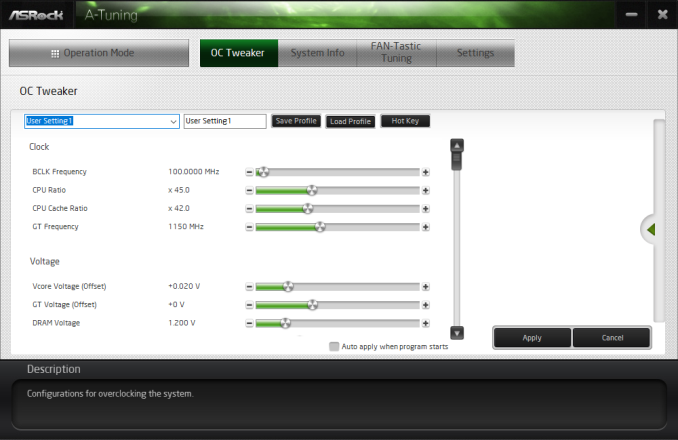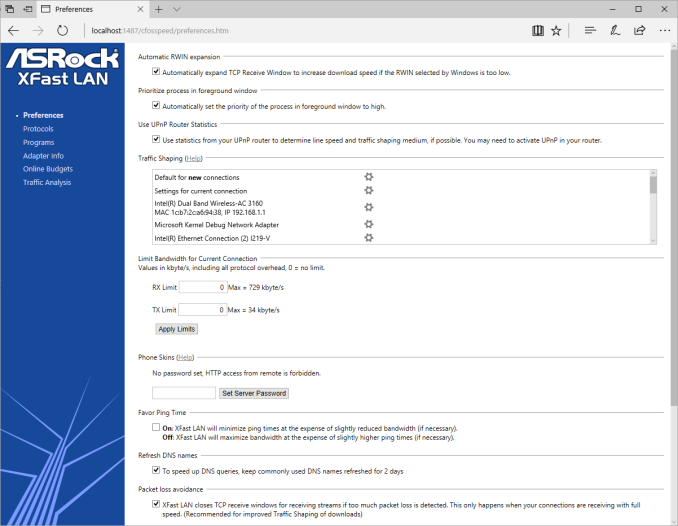The ASRock Z270 Supercarrier Motherboard Review: 4-way SLI and 5 Gigabit Ethernet on Kaby Lake
by E. Fylladitakis on September 29, 2017 9:00 AM EST- Posted in
- Motherboards
- ASRock
- SLI
- Aquantia
- Z270
ASRock Z270 Supercarrier Software
Despite the motherboard’s class and price, ASRock made no effort to develop a software package any more advanced than what comes with their mainstream motherboards. The driver DVD has a very basic automated installer software with five tabs. The first tab lists all of the drivers and software that are compatible with this motherboard, plus Google’s Chrome Browser and Toolbar, even though these have their own tab. There is an “Install all” option that automatically installs everything, without leaving any room for the user to select what should be installed and what not. The “Utilities” tab is practically empty, with only the “Restart to UEFI” software to be found here, a simple shortcut that restarts the PC and automatically enters the BIOS. Manuals and guides can be found under the Information tab and, finally, the company’s contact information is all that can be seen under the Contact tab.
The core software package that accompanies the ASRock Z270 Supercarrier, and practically all of ASRock’s motherboards today, is the ASRock App Shop. This application doubles as a software “shop” and as an updates installer. Extra software packages that can enhance the system’s devices, offer more options, and even some basic games can be downloaded and installed.
ASRock’s A-Tuning utility is the software package that allows for overclocking, fan tuning and monitoring via the OS. In its “OC Tweaker” tab we found many of the settings that are accessible via the BIOS screen, allowing for casual overclockers to experiment with minimal risk, as the settings reset when the system restarts. It is also handy for people who do not want a permanent overclock forced via the BIOS but prefer to boot with stock settings and force an overclock whenever they want or after the OS has booted.
The ASRock XFast LAN technically is the well-known cFos software with ASRock’s skin. This software allows the user to prioritize network traffic according to his/her needs. For example, it can be set to prioritize the traffic of a specific game/application over a downloading/file sharing app or server. This is particularly useful for applications where seamless network traffic can be vital, such as, for example, when there are IP security cameras connected to the computer and they should not be disturbed by the downloading of a large OS update or other files.



















50 Comments
View All Comments
wiyosaya - Friday, September 29, 2017 - link
I am confused! 4-way SLI? Am I living in a time bubble or something? I thought that nVidia announced some time ago that they were focusing on 2-way SLI due to scaling issues and that support for 4-way SLI would be minimal in the future.Besides, with 4-lane pci-e on this thingy, if anyone really wanted to do 4-way SLI, it seems like Threadripper (or sIntel's equivalent enthusiast parts) would be a much better platform for 4-way SLI.
Maybe ASRock is just trying to prolong the wave artificially.
MadAd - Friday, September 29, 2017 - link
there are other niche uses for 4 way, a hobbyist mining rig, a small render farm for blender, or the well off who just want to throw money at making a stonking pcBrokenCrayons - Friday, September 29, 2017 - link
Typical GPU mining on a large scale can work with a 1x PCIe slot so four 16x slots aren't really of any added value for that sort of situation.Notmyusualid - Friday, September 29, 2017 - link
4x SLI on Pascal works. I have 4x 1070 FTWs in my main rig. Search it out on a well-known video site.Due to installed PCIe switches, all four of my GPUs 'see' a x16 3.0 slot each, but they are multiplexed together to share 40 available lanes from the CPU, and this seems more than plenty, so I shake my head to comments fighting over how many lanes you have over this amount, because this works just fine. *Maybe* 28 would be too few, but 40 is just fine. Depends on what you are doing I suppose.
I won't be buying Threadripper due to what I see as confusion over different modes of operation, and possible latency issues (depending on application), and the multiple internal dies. Back in the day, it amused me to see people poking fun at the 'Core 2 Quads' for not being 'real' quad cores, but nobody I have seen has mentioned that TR is not just two - but FOUR separate dies on the same package, whilst the competition - Intel, has all its cores on a single die / package this time around (as far as I know).
I'm slightly impressed with TR, but not enough to buy it, given I already have 14c/28t Xeon.
supdawgwtfd - Sunday, October 1, 2017 - link
TR is 2 dies.The other 2 dies are just there to help support the IHS.
Perhaps if you weren't completely ignorant you would know this. And saying TR is confusing compared to Intel is a laugh.
Had a look at Intel's X299 line up at all?
Noticed that they have many different CPUs all with different pcie lanes?
Now THAT is confusing.
Notmyusualid - Sunday, October 8, 2017 - link
Well stone me. 2 / 4 dies? It still leaves the opportunity for increased latency, as some sites have mentioned. So my comment stands.But yes, recent Intel confusion with socket / chipset compatibility leaves much to be desired. No way I'm going to defend that. But you'll know when you build your Intel rig, core-core latencies will be lower.
rocky12345 - Friday, September 29, 2017 - link
Great review as always thanks.It seems weird that the MB makers are releasing so many z270 boards when it is basically at the end of life even before a year is up from when it was released. I guess Intel caught the MB makers off guard here as well and they are stumbling fast to get these boards out ASAP because of the R&D it cost to design them.
timecop1818 - Saturday, September 30, 2017 - link
This board was released months ago (like April 2017 or earlier), they just got around to reviewing itrpjkw11 - Friday, September 29, 2017 - link
I really like the three M.2 connectors. I have no need, yet, for U.2, but I long ago ditched HDDs and now run two SSDs.rsandru - Friday, September 29, 2017 - link
The NE5532 is an op-amp and not a headset amplifier.It's been first released in 1985 and has been found in all kinds of electronics since then because it's cheap. I'm struggling to find a reason why it's mentioned as some sort of feature...